Part 1: Bestiary
Small monsters
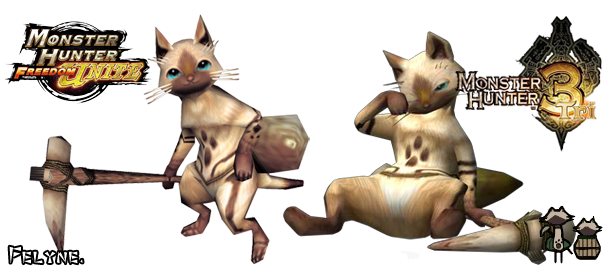
Bipedal creatures resembling cats, known for their light hair. Though usually docile, they will attack viciously if provoked. Naturally curious, some try to enter human society. Fond of Felvine, they will follow its scent anywhere.
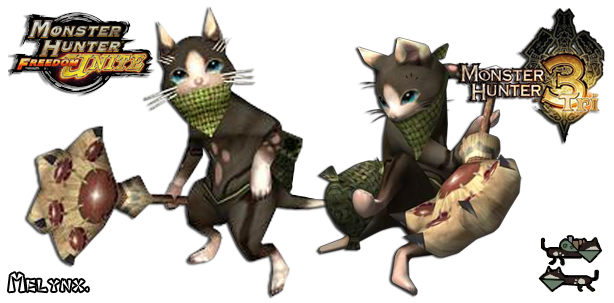
Cat-like humanoids called Lynians with black fur. Their sticky-fingers never miss a chance to steal things and take them back to their den, forcing victims to seek out their lost items. Distracted by the sight of Felvine.
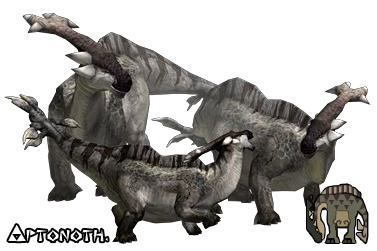
Relatively docile herbivores with characteristic crest plates. They form herds and raise young communally, and have been used as pack animals for generations; their meat is tasty and nutritious. Very cautious around large monsters.
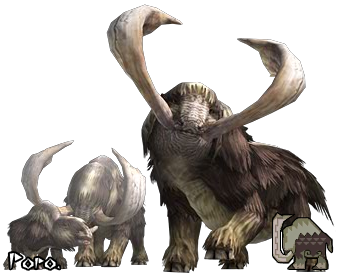
Herd-forming herbivores. Covered in thick fur to endure the cold. Popo are gentle, but known to use their massive tusks bravely when defending their young. Popo meat is very nutritious; the tongue is said to be especially palatable.
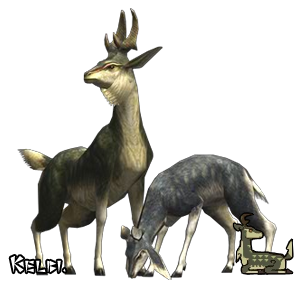
Herbivorous, deer-like monsters. Valued for their horns, they tend to run away at the first hint of danger. They are also hunted for their meat, which is chewy but flavorful.

Submissive, water dwelling herbivores that subsist on water grasses and moss. Epioth frequently surface to sunbathe. Extremely timid, they panic when danger is near, swimming about in a haphazard fashion.
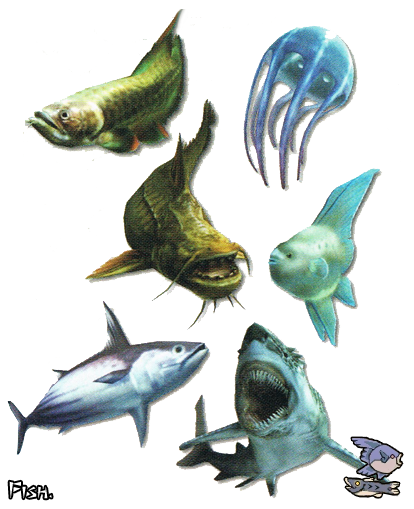
This category includes carnivorous fish (Sharq, Catfish), migratory fish (Tuna, Arowanas), and natatorial fish (Molids, Perciformes). Fish often flee when attacked, so hunters prefer to use harpoons to obtain materials from them.
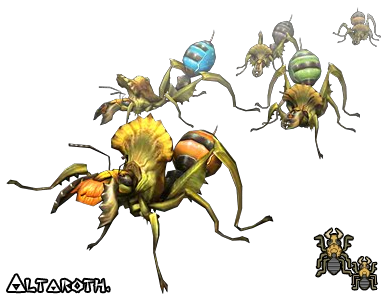
Insects that widely inhabit many areas. Noted for absorbing fruit, mushrooms and honey, then carrying them back to their nest. Materials can thus be collected from their swollen abdomens, whose color is related to what is being carried.
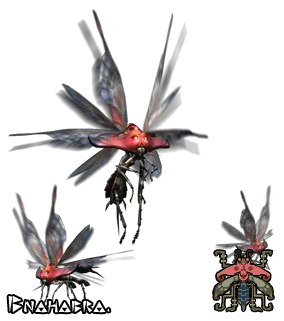
Flying insects that inhabit most environments. They attack invaders with a paralyzing poison and lay eggs in carrion together with a bodily fluid that hastens decomposition. Attracted to light, they will gather around any fire.
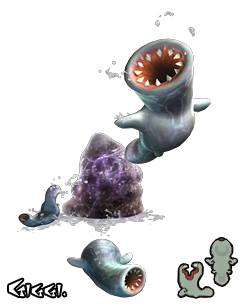
Wyvern larvae. Reasonably fecund, they can survive in any dark environment. Giggi are sensitive to light and heat, and so avoid torches. They are also known to leech from other animals, converting it into toxins.
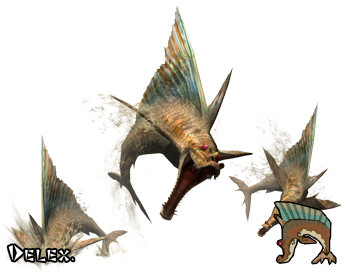
Carnivorous monsters that inhabit deserts. Delex always travel in schools of five or six. When near large monsters on a hunt, they attempt to surround the prey and scavenge food. Known to flee if other Delex are injured.

Extremely territorial herbivores with poor vision but acute hearing. Rhenoplos will doggedly pursue any nearby targets they sense. They often collide into boulders, perhaps because they can't easily stop themselves once they begin running.
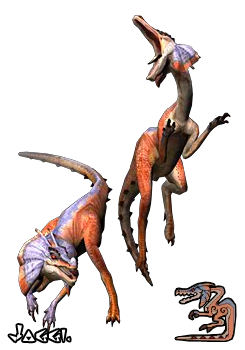
Highly social, carnivorous bird wyverns found in large packs. Young Jaggi males hunt in groups, attacking much larger animals. Current research suggests they operate under orders from an alpha male. Aggressive but wary of fire.

Female Jaggi that stay in groups, Jaggia generally cluster around the nest to defend it and raise whelps. Smaller than mature males, but larger than and tougher than the countless young males. Jaggia also operate under an alphas orders.
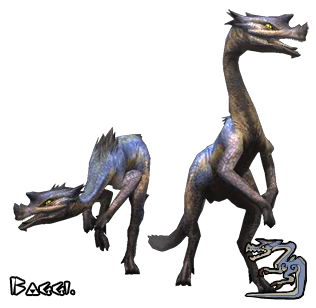
Highly intelligent, carnivorous Bird Wyverns that hunt in packs. Noted for their blue scales and sharp glare. Baggi are feared for their ability to release a tranquillizing fluid; it can knock out even humans for several seconds.
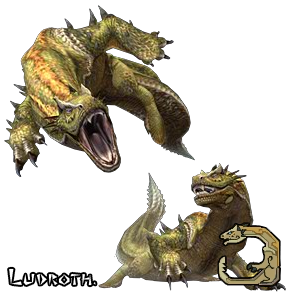
Aquatic female monsters. Ludroth form "harems" around large males, hence gathering in territories designated as breeding grounds. They are known to be extremely aggressive towards outsiders; caution is advised.
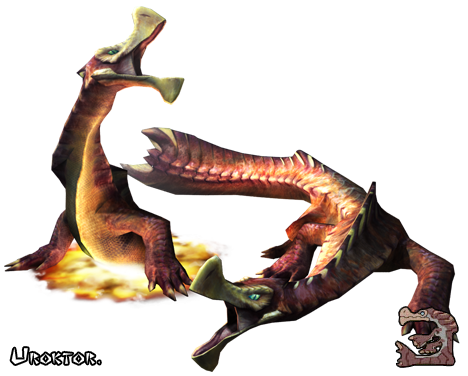
Leviathans that inhabit volcanoes. Noted for swarming around larger monsters' kills in order to feed. Uroktor rarely hunt for themselves, but stab upward at prey from the ground when they do. Known for being highly aggressive.
Large monsters
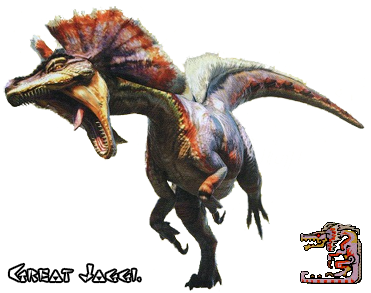
The Great Jaggi is the head of a Jaggi pack. At a certain age, males leave the pack to live on their own for a period of time before returning to fight for the right to be a leader. They have a very commanding presence. It is said they can call and give complex orders to their pack with their howls and barks.
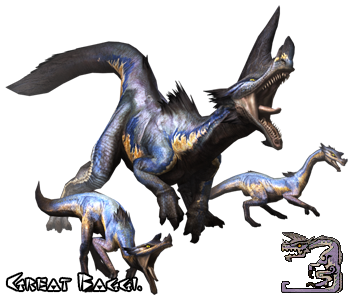
Carnivorous bird wyverns like the Jaggi. Noted for their projecting cranial crests and bluish-white skin that's adapted to snow. Great Baggi craftily command other Baggi to surround their prey and stun them with a tranquilizing fluid.
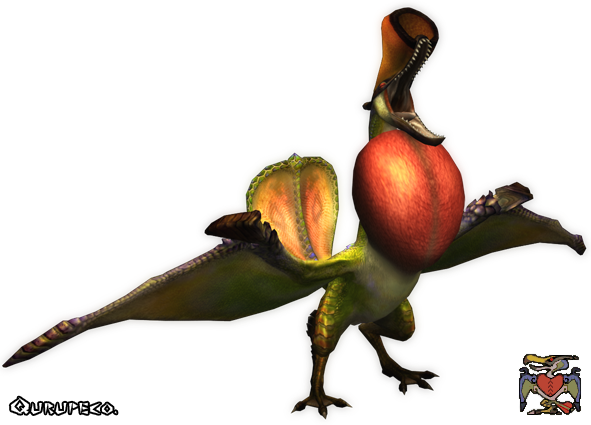
Bird Wyverns with unique plumage. Well known for using their thoracic vocal organs to imitate others monsters calls, first summoning them, then using the distraction to flee. Spits a dangerous combustible body fluid.
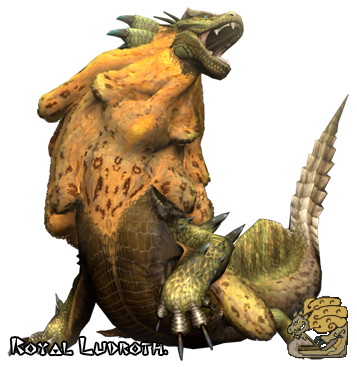
Royal Ludroth use their sponge like neck scales to absorb water and prevent drying out on land. Once the sponge loses moisture, they attempt to re-enter the water. They also spew mucus to trip up their prey.
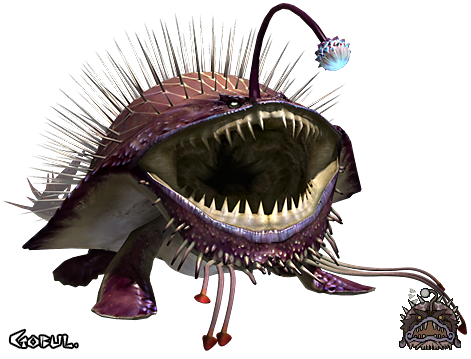
Monsters with strong camouflage skills and powerful neurotoxins. Poor swimmers, Gobul conceal themselves and lure prey by imitating plants with their barbels. Can reportedly swallow Epioth whole. They love frogs.
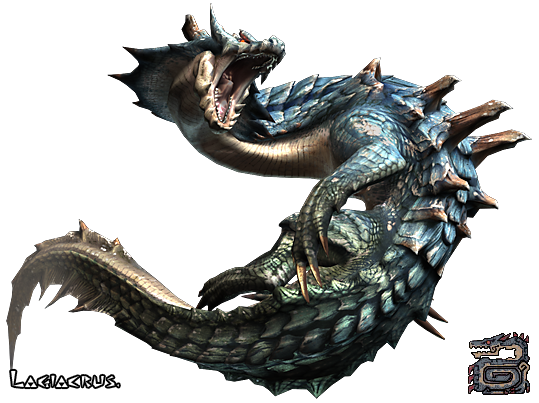
Known as Sea Wyverns, Lagiacrus are at the top of the aquatic food chain. Feared by sailors as 'The Lords of the Seas', they store enough electricity in their spinal organs to make the oceans surge. Occasionally seen resting on land.
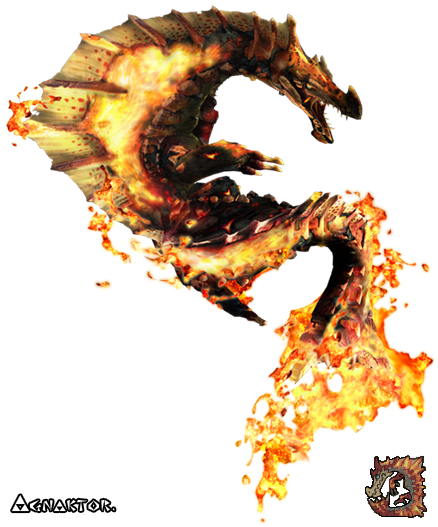
Also known as fire-pike wyverns, Agnaktor use their tough beaks and great strength to burrow through rock, and sometimes even cave ceilings. Encrusted with hardened lava that can soften from the heat when they spit magma or burrow.
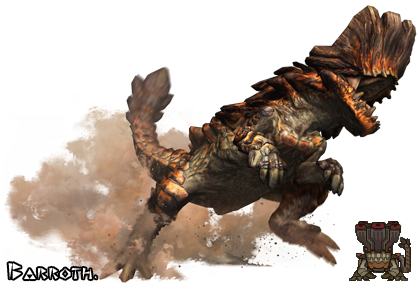
Barroth usually remain beneath the mud, perhaps to shield themselves from heat; they are even known to fling mud to attack. They will charge in a frenzy at anything that disturbs their bogs.
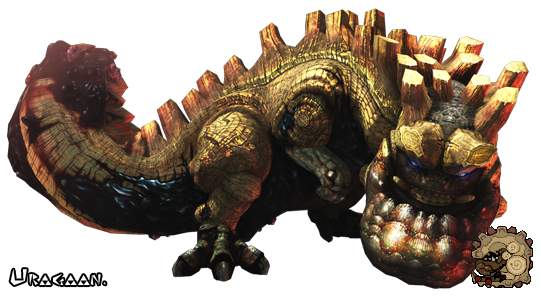
Brute wyverns that feed on ore, using their mighty jaws to crush bedrock into powder. They cleverly affix rock and ore to themselves with lava, then spread them about, using vibrations to make them explode. Will sometimes drop ore.
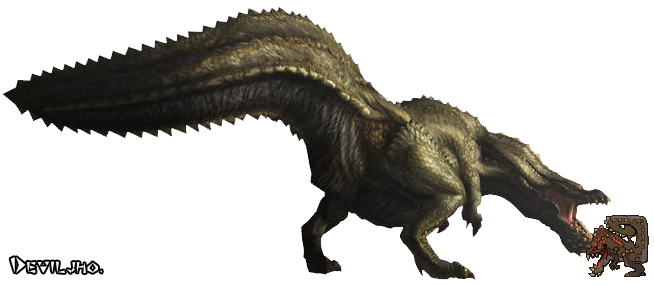
The dreaded, nomadic Deviljho have no specific territory of their own. Their muscles swell if provoked, revealing old wounds. Needing to feed constantly due to high body heat, they can hunt nearby animals to extinction.
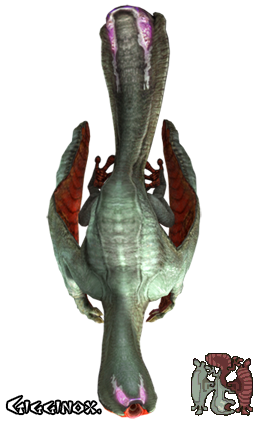
Wyverns that inhabit the Tundra. Known to stun prey with poison, then freeze the meat in caves. Gigginox live in darkness and thus have degraded vision; they detect prey through body heat. Extremely fertile, laying innumerable eggs.
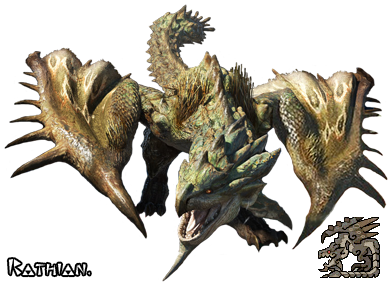
Fire-breathing female wyverns, also known as "Queens of the Land." With powerful legs and poison-secreting tails, they hunt mainly on the ground. Sometimes seen preying as a couple, Rathian cooperate well with Rathalos.
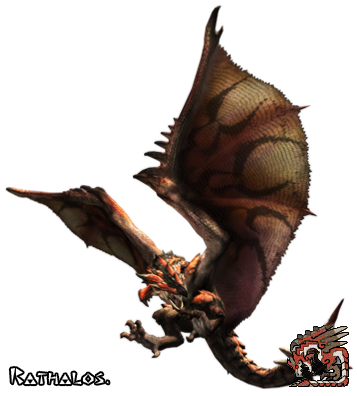
Terrible wyverns called the 'Kings of the Skies'. Together with Rathian, they stake wide territories centered around their nests. Rathalos descend on invaders from the sky, attacking with poison claws and breath of fire.

Wyverns feared as desert tyrants. Extremely territorial, Diablos attack invaders with blind aggression. Highly sensitive to sound, perhaps because they frequently travel beneath the sand. Known to feed on cacti.
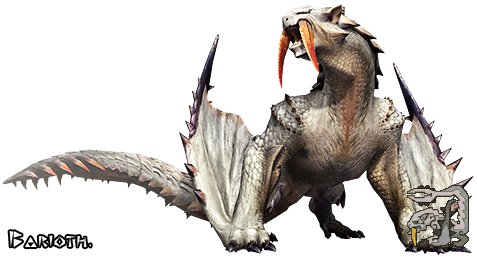
Wyverns that rule the eternally frozen Tundra. Barioth use their huge tusks and spiked scales to move freely atop the slippery ice; this ability makes them very difficult to keep up with.
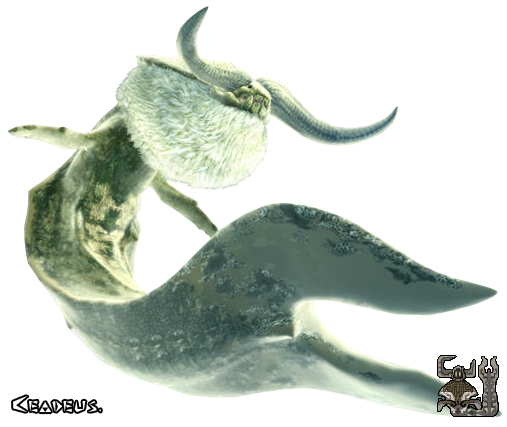
Legendary elder dragons known as both "shining giants of the depths" and "great sea dragons." Not confirmed to exist until recently. The Moga quakes were due to a Ceadeus butting its abnormally long horns into the earth.
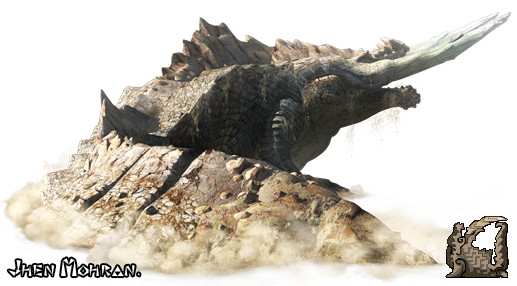
Rare ore can be mined from these enormous dragons' backs; thus they are considered prosperity symbols. They swallow vast amounts of organic material and are always surrounded by scavenging Delex, which sailors use to locate them.
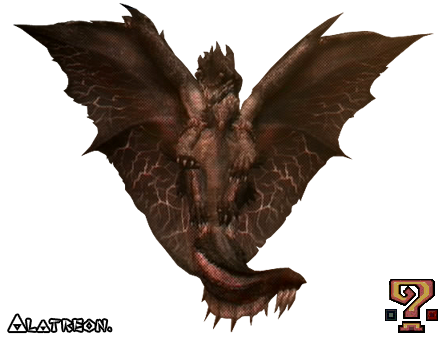
Blazing black dragons, so named for resembling both lightning and darkness. They mercilessly tear apart whoever touches their sharp scales. Elementally unstable, their actions can affect the very weather. Living natural disasters.